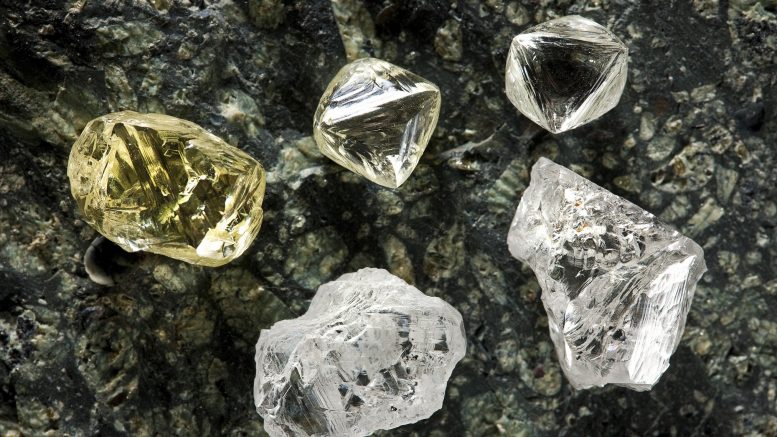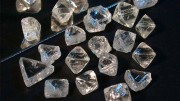Star Diamond (TSX: DIAM) has tabled a new preliminary economic assessment (PEA) on its Star-Orion South diamond project in the Forte à la Corne diamond district in central Saskatchewan, 60 km east of Prince Albert.
According to the study, the project could produce 470 million tonnes grading 14 carats per hundred tonnes (cpht) for 66 million carats over 34 years. The project has an after-tax net present value of $2 billion at a 7% discount rate and a 19% internal rate of return.
Based on a December 2015 resource estimate, the Star kimberlite contains 193 million indicated tonnes grading 15 cpht for 28.3 million carats as well as 57 million inferred tonnes grading 11 cpht for 6.4 million carats. Orion South contains 200 million indicated tonnes grading 14 cpht for 27.2 million carats plus 72 million inferred tonnes at 7 carats for 5.2 million carats.
The company says a significant portion of its diamonds are rare, high-value Type IIa stones.
Notably, Star Diamond now pegs pre-production capital at $1.4 billion, a $500-million drop from its 2011 feasibility study (FS) estimate.
“Most people found that number unpalatable at the time,” Star Diamond’s vice-president of exploration George Read says in an interview with Diamonds in Canada.
Read attributes the cost reduction largely to the company’s plan to use bucket wheel excavators to clear the “vast quantity of overburden” covering the kimberlites. In the FS, the company had decided to remove the overburden, which consists of sand, clay and till, using a truck and shovel system that Read says was very expensive.
The company visited coal mines in East Germany that Read says have to remove a similar type of overburden.
“They’ve been using bucket wheel excavators for over 50 years, and very successfully,” Read says.
Star Diamond can use three excavators at Forte à la Corne to remove overburden for as little as 55¢ per tonne. Read adds that although bucket wheel excavators were used unsuccessfully in Canada in the past, malfunctioning in cold weather, he believes that thanks to the use of optic oils those issues have largely been resolved.
Star Diamond has plans to operate two open pits, one at Orion South and one at Star. It would start with Orion South.
“At Star we have sand and clay, till, then some low-grade kimberlite, before better ore at around 135 metres,” Read says.
“At Orion South, from till you go directly into the kimberlite at 90 metres. In economic terms, you can access the payable ore quicker.”
The company is also touting what it calls “state of the art” processes to recover larger diamonds from its project without breaking them. It says standard processing plants can easily break large stones, making them far less valuable.
Its solution is to use X-ray transmission sorters supplied by Tomra Sorting. Tomra has used its technology in recycling and food sorting, and according to Read, the cost of running its machines is “much more manageable” than the standard process for diamond recovery.
During its evaluation process, the company found a 49.5-carat stone at Star and a 45.9-carat stone at Orion South — which it says is unusual for that stage of exploration.
“Diamond populations are naturally log-normal distributions, meaning that there are exponentially more little ones than big ones,” Read says. “However, in our case we have the opportunity to recover some significantly large stones, not dissimilar to what’s seen in the famous kimberlites in southern Africa.”
Star Diamond acquired a 100% interest in Forte à la Corne in June 2017 from Newmont Mining (NYSE: NEM). It currently has a staged option agreement with Rio Tinto (ASX: RIO) to joint-venture the project. The first stage requires Rio Tinto to complete a 10-hole bulk sampling program or spend $18.5 million on the project. Rio Tinto has three years to complete the first stage, which will not earn it any interest.
In January 2018, Rio Tinto completed overburden drilling for 10 holes. It announced in April it had finalized contractual arrangements for Bauer BC 50 cutter rigs from Nuna Logistics.
The company will drill up to 250 metres below surface and extract 100 tonnes of kimberlite for every 10 metres.
Star Diamond, formerly Shore Gold, began trading under its new name in February 2018. Its shares are valued at 19¢ with a 52-week range of 17¢ to 24¢. The company has a market capitalization of $72 million.
—Richard Quarisa is a staff writer with The Northern Miner.
This article originally appeared in the June 2018 issue of Diamonds in Canada magazine.



Be the first to comment on "New PEA slashes pre-production costs for Star-Orion South"